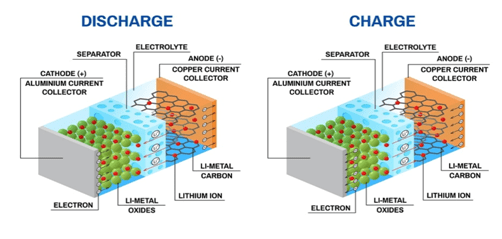UPSC Articles
Four-fold jump in Li-ion battery imports since 2016
Part of: GS Prelims –Science & Tech and GS-III- Technology
In news:
- India has quadrupled its imports of lithium-ion (Li-ion) batteries
- lithium-ion are vital for powering a range of devices from cellphones to electric vehicles
- India lacks manufacturing capacity;
- India is world’s largest importer
- Imports from China, Japan and South Korea
- To promote indigenous development of such batteries, the Union Cabinet in 2019 approved a programme, called a National Mission on Transformative Mobility and Battery
- Electric vehicles are expected to account for a significant share in the growth of the Li-ion battery demand in India
- The government has announced investments worth $1.4 billion to make India one of the largest manufacturing hubs for electric vehicles by 2040.
From Prelims point of view :
lithium-ion
- Rechargeable battery.
- Used for portable electronics and electric vehicles
- Developed by John Goodenough, Stanley Whittingham, Rachid Yazami and Akira Yoshino
- Lithium ions move from the negative electrode through an electrolyte to the positive electrode during discharge, and back when charging.
- Li-ion batteries use an intercalated lithium compound as the material at the positive electrode and typically graphite at the negative electrode.
- There is a safety hazard since they contain a flammable electrolyte, and if damaged or incorrectly charged can lead to explosions and fires.
- Samsung were forced to recall Galaxy Note 7 handsets following lithium-ion fire

Daily Current Affairs IAS | UPSC Prelims and Mains Exam – 10th February 2020
National Mission on Transformative Mobility and Battery:
- Recommend and drive the strategies for transformative mobility and Phased Manufacturing Programmes for EVs, EV Components and Batteries.
- A Phased Manufacturing Program (PMP) will be launched to localize production across the entire EV value chain.
- Determine the contours of PMP, and will finalise the details of such a program.
- The details of the value addition that can be achieved with each phase of localisation will be finalised by the Mission with a clear Make in India strategy for the electric vehicle components as well as battery.
- The Mission will coordinate with key stakeholders in Ministries/ Departments and the states to integrate various initiatives to transform mobility in India.
Electric vehicles:
- An electric vehicle, uses one or more electric motors or traction motors for propulsion.
- An electric vehicle may be powered through self-contained battery, solar panels or an electric generator to convert fuel to electricity.
*** E vehicles and policy related to it will be soon dealt in the mains section














